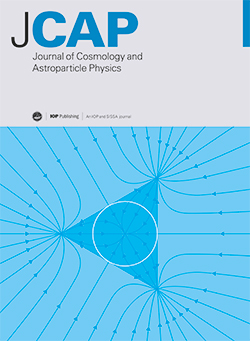Calibration requirements for epoch of reionization 21-cm signal observations. Part IV. Bias and variance with time and frequency correlated residual gains
IF 5.9
2区 物理与天体物理
Q1 ASTRONOMY & ASTROPHYSICS
Journal of Cosmology and Astroparticle Physics
Pub Date : 2025-07-08
DOI:10.1088/1475-7516/2025/07/024
引用次数: 0
Abstract
Observation of multifrequency angular power spectrum of the redshifted 21-cm brightness temperature fluctuation from the neutral hydrogen holds the key to understand the structure formation and its evolution during the reionization and post-reionization era. A major challenge in observing the neutral hydrogen arises from presence of strong foreground signals in the frequency range of interest. Mitigating the direct effect of foregrounds are being addressed through various techniques in literature. An additional second order effect arises, in presence of foreground, with limited accuracy in time and frequency dependent gain calibrations. This manifests as the residual gain and bandpass error in the observed data, introduces bias and increases uncertainty in the estimates of multifrequency angular power spectrum. In this work, we present an analytic method to estimate the bias and excess uncertainty in the estimates of multifrequency angular power spectrum in presence of residual gain and bandpass errors. We use this framework to estimate the effect of these errors for detection of redshifted 21-cm emission from a redshift of ∼ 8 with the upcoming SKA1-Low. Due to the high baseline density at the required range of angular multipoles, the SKA1-Low is found to be a tuned instrument for the redshifted 21-cm signal detection. We find that, there are scenario with residual gain and bandpass errors where there can be significant bias in these estimates. Certain foreground mitigation strategies, is expected to reduce a part of the bias. The detailed study of different aspects of gain and bandpass errors and their relative effects are discussed. We find, with assumed models of gain and bandpass errors, signal detection is possible at this redshift with 128 hours of observations. However, to achieve this one needs to have better calibration accuracy than present day interferometers.再电离21厘米信号观测历元的校准要求。第四部分:偏差和方差与时间和频率相关的剩余增益
观测中性氢红移21 cm亮度温度波动的多频角功率谱是了解再电离和后再电离时期结构形成及其演变的关键。观测中性氢的一个主要挑战是在感兴趣的频率范围内存在强烈的前景信号。减轻前景的直接影响正在通过各种技术在文献中解决。在前景存在的情况下,会产生额外的二阶效应,在时间和频率相关的增益校准中精度有限。这表现为观测数据中的剩余增益和带通误差,引入偏置并增加了多频角功率谱估计的不确定性。在这项工作中,我们提出了一种分析方法来估计存在剩余增益和带通误差的多频角功率谱估计中的偏差和过度不确定性。我们使用这个框架来估计这些误差对即将到来的SKA1-Low在红移~ 8时检测红移21 cm发射的影响。由于在角多极所需的范围内具有较高的基线密度,SKA1-Low被发现是用于红移21厘米信号检测的调谐仪器。我们发现,有残余增益和带通误差的场景,在这些估计中可能存在显著的偏差。某些前景缓解战略,有望减少部分偏倚。详细研究了增益和带通误差的不同方面以及它们的相关影响。我们发现,假设模型的增益和带通误差,信号检测是可能的,在这个红移与128小时的观测。然而,要实现这一点,需要比目前的干涉仪有更好的校准精度。
本文章由计算机程序翻译,如有差异,请以英文原文为准。
求助全文
约1分钟内获得全文
求助全文
来源期刊

Journal of Cosmology and Astroparticle Physics
地学天文-天文与天体物理
CiteScore
10.20
自引率
23.40%
发文量
632
审稿时长
1 months
期刊介绍:
Journal of Cosmology and Astroparticle Physics (JCAP) encompasses theoretical, observational and experimental areas as well as computation and simulation. The journal covers the latest developments in the theory of all fundamental interactions and their cosmological implications (e.g. M-theory and cosmology, brane cosmology). JCAP''s coverage also includes topics such as formation, dynamics and clustering of galaxies, pre-galactic star formation, x-ray astronomy, radio astronomy, gravitational lensing, active galactic nuclei, intergalactic and interstellar matter.
 求助内容:
求助内容: 应助结果提醒方式:
应助结果提醒方式:


